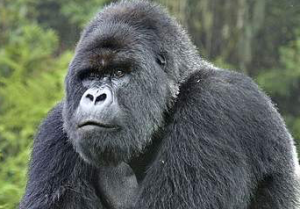Scientists have discovered changes in the human microbiome when compared to those of our closest relatives, the Great Apes.
Scientists who examined the bacteria in chimpanzee and gorilla faeces discovered that they have seasonal changes in the type of intestinal flora brought about by the changes in their diet at different times of the year. Whereas humans are now able to source all kinds of food throughout the year which means that the intestinal flora stays the same. According to scientists, who now place increasing emphasis on the importance on the role of gut bacteria in human health this could implications for our wellbeing.

The types and numbers of bacterial species that inhabit the human gut depend on what we eat. And, as humans have changed their diet over time, the microbiome has followed suit, according to a recent study published in Nature Communications.
The Western diet, in particular, is wholly different to that of our ancestors just 100 years ago — let alone early humans who walked the earth millions of years ago.
The human digestive system, though it does have differences from our closest relatives — the other great apes — is relatively similar. And, when our species first split and went off on our own evolutionary path, our diets probably had a lot in common, too.This means that the bacteria types living in our gut were, at least initially, pretty similar to our hairier cousins. There are still similarities today, but, as our diet has shifted, so has our microbiome.What this huge change in our diet means for our microbiome and related health is a tricky question to answer.
Researchers at the Center for Infection and Immunity at Columbia University’s Mailman School of Public Health in New York City, NY, investigated ape bowel waste. Specifically, they examined fecal samples from great apes living in the Sangha region of the Republic of Congo, collected by the Wildlife Conservation Society.
Their sampling was spread over three years, in order to give them an idea of how gut bacteria populations shifted seasonally.
The authors noted that, in chimpanzees and gorillas, the microbiome changed significantly with the seasons, along with their diet. In the hot, dry summer, for instance, fruits are their primary food source, whereas for the rest of the year, their diet is mostly fibrous leaves and bark.
Brent L. Williams, Ph.D., an assistant professor of epidemiology, explains one of the primary changes they evidenced: “Bacteria that help gorillas break down fibrous plants,” he says, “are replaced once a year by another group of bacteria that feed on the mucous layer in their gut during the months they are eating fruits.”
Interestingly, the changes mirrored those of the Hadza hunter-gatherer people from Tanzania, who similarly rely on seasonal food availability.
In contrast, as far as the average U.S. citizen’s microbiome is concerned, seasonal changes do not occur. We can access pretty much any food type we want at any point in the year.
The team noted other differences, too. According to first study author Allison L. Hicks, “While our human genomes share a great deal of similarity with those of our closest living relatives, our second genome (the microbiome) has some important distinctions, including reduced diversity and the absence of bacteria and archaea that appear to be important for fibre fermentation.” Do these differences matter to our health?
“The fact that our microbiomes are so different from our nearest living evolutionary relatives says something about how much we’ve changed our diets, consuming more protein and animal fat at the expense of fibre,” says Williams.
As mentioned earlier, during the fibre-poor summer months, the microbiome of the great ape is dominated by a strain that feeds on the gut’s mucous layer.”Many humans may be living in a constant state of fibre deficiency. Such a state may be promoting the growth of bacteria that degrade our protective mucous layer, which may have implications for intestinal inflammation, even colon cancer.”
As Hicks says, “Understanding how these lost microbes influence health and disease will be an important area for future studies.”
